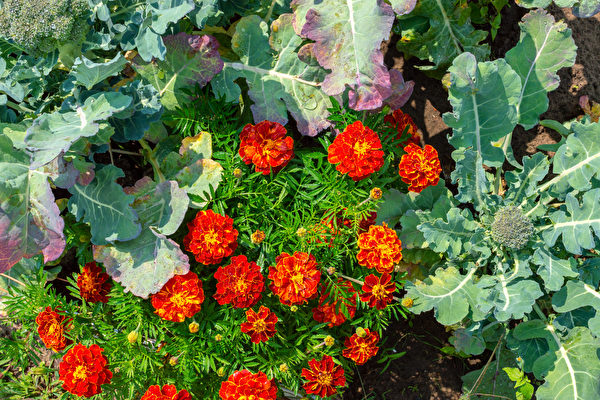Many people enjoy growing vegetables in their own gardens but often struggle with pest infestations. In fact, there are some simple strategies that can help you prevent or reduce pest damage, making your gardening experience more enjoyable.
It is currently the planting season, and you may be planning your garden plot and purchasing seeds. If you prefer not to use pesticides and want your vegetables to grow vigorously while avoiding pest attacks, the following five strategies may be helpful.
Companion planting, also known as intercropping, is a method where you plant certain plants together to benefit each other. For example, if you want to grow a plant that attracts certain pests, you can plant another type of plant next to it that repels those pests. Marigolds are popular among organic farmers for their ability to repel insects and nematodes, making them an important companion plant.
Planting marigolds alongside tomatoes is a good choice. A study by Newcastle University in March 2019 revealed that marigolds release a large amount of limonene, which helps repel whiteflies that can harm tomatoes.
In addition to pest repellent benefits, companion planting can also promote plant growth. For instance, eggplants can be planted alongside legumes, as eggplants require a lot of nitrogen to thrive, which legumes provide. However, eggplants require adequate sunlight, so choosing the right position to avoid shading from legume vines is important when companion planting with legumes.
When planting specific vegetables, selecting varieties known to be resistant to common pests can help you avoid pest issues. Take some time to research seed catalogs before making a purchase to find suitable varieties. For example, look for carrot varieties resistant to carrot flies, or potatoes that can withstand nematode attacks.
Mixing different crops together also confuses pests, making it harder for them to locate their preferred plants. You can achieve this by intercropping different vegetables or mixing vegetables with herbs or flowers to create a more diverse and confusing planting scheme.
Another seemingly simple strategy is planting vegetables outside of peak pest periods. For example, flea beetles tend to peak in activity during mid-summer and can leave tiny holes in leaves of Brassica vegetables. You can plant Asian greens and mustard greens in autumn when flea beetles are less active. Planting before pests arrive can also be effective, especially for quickly maturing early peas to avoid destructive pea moth infestations.
Ladybugs, hoverflies, parasitic wasps, and lacewings are beneficial insects that help control pests by either preying on them or laying eggs inside pest bodies. By planting plenty of their favorite flowers like cosmos, sweet alyssum, and dill, you can attract more beneficial insects to your garden. For maximum pest control effectiveness, plant these flowers in between or adjacent to your vegetable crops.
(This article was referenced from the gardening website GrowVeg.com)

